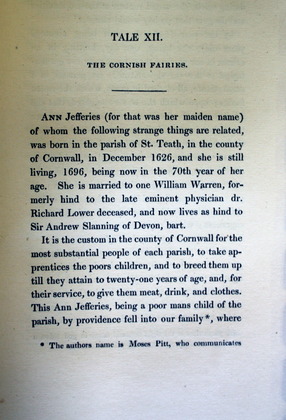Christianity and Moral Didacticism
This ‘true’ account of a young woman’s encounter with fairies is of particular note because the source from which Ritson gleaned it, dated 1696, was written by ‘the right reverend father in god Edward Fowler lord bishop of Gloucester’ (p.126). As it is a transcribed oral tale, opposed to an authored fairy tale, it adheres instead to the genre of folk-tales, and this marrying of the religious with what would later be considered by the Christian church as profane would be potentially controversial for a Victorian readership. Not only does the cleric subscribe to the existence of the supernatural/magical, he cites religious scripture to support Jeffries’ claims: ‘1st epistle of St. John, chap. 4, ver. 1. “Dearly beloved, believe not every spirit, but try the spirits, whether they be of god, &c.”’ (p.131).
The case of Anne Jeffries and her encounter with the fairies was one of the most widely documented ‘supernatural’ phenomenon of her time- as well as being prolifically reproduced in pamphlets, there is also a letter detailing events pertaining to it in the Clarendon Manuscripts dated c. March 1647. Jeffries, as the tale suggests, was imprisoned in Bodmin jail for heresy; Ritson, however, instead of adopting the stance of the Christian right, concedes in his conclusion that ‘the facts […] are so fairly represented, and so authentically proved, that no pious Christian, who sincerely believes the gospel, can hesitate, for a moment, to admit its veracity’ (p.133). As a respected antiquarian, his support of the tale as an account of a potentially religious encounter would surely have been contentious at the time of publication, particularly as the Christian and Utilitarian right were making great pains to restrict the public’s consumption of fanciful folk-tales. Oral tales in particular, which had a well-established role in rural communities, were charged with deep-seated social tensions and viewed as posing a tangible threat to both church and state.






